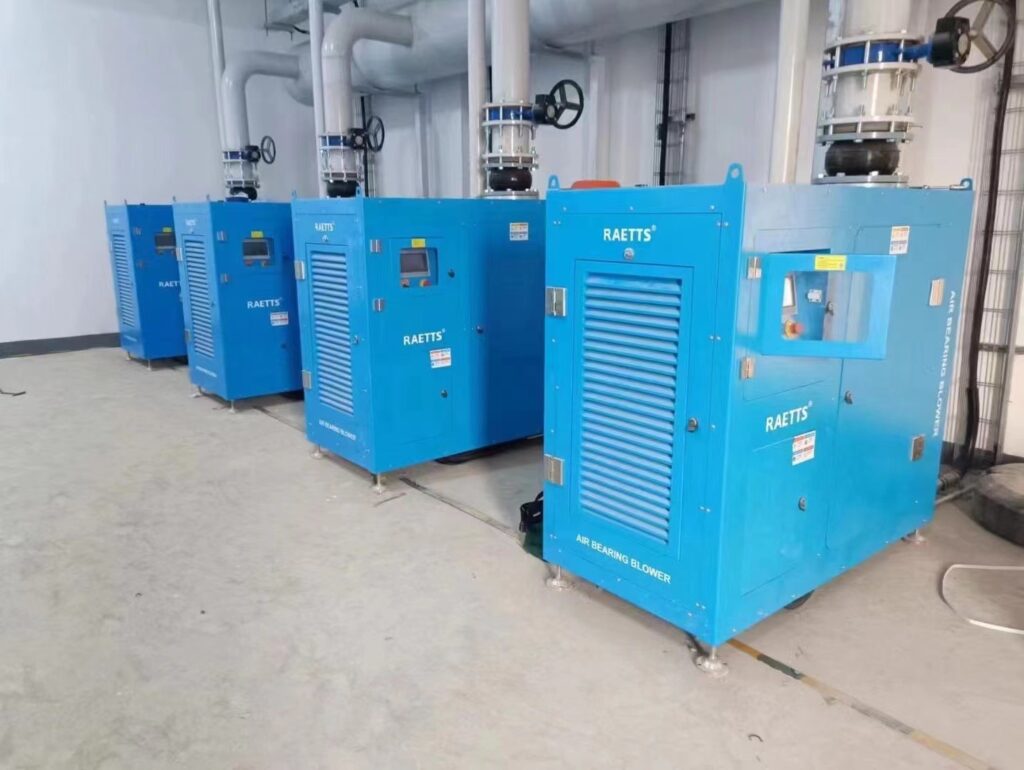When it comes to industrial applications, choosing the right blower can significantly impact efficiency, performance, and operational costs. RAETTS, a leading air blower manufacturer, offers comprehensive solutions in the form of maglev turbo blowers and axial blowers. This article explores the key differences between these two types of blowers, helping you make an informed decision.
Efficiency
Part I. Maglev Turbo Blower:
Maglev turbo blower utilizes magnetic levitation technology, which allows the impeller to float on a magnetic field, eliminating mechanical contact and friction. This results in exceptionally high efficiency, as energy losses due to friction are minimized. The advanced design also allows for variable speed control, optimizing energy usage based on demand.
Part II. Axial Blower:
Axial blower, on the other hand, operates by moving air along the axis of the impeller. While axial blower is generally efficient for high-volume, low-pressure applications, they tend to have lower efficiency compared to maglev turbo blower in variable load conditions. However, axial blowers are simpler in design and can be more suitable for specific applications where consistent airflow is required.
Performance
Part I. Maglev Turbo Blower:
Maglev turbo blower boasts superior performance in terms of airflow and pressure capabilities. The lack of mechanical friction not only enhances efficiency but also extends the operational lifespan of the blower. These blowers are capable of delivering precise and consistent airflow, making them ideal for applications requiring high reliability and performance.
Part II. Axial Blower:
Axial blower is known for their ability to handle large volumes of air at lower pressures. They are particularly effective in ventilation and cooling applications where high airflow is needed. Although they may not match the pressure capabilities of maglev turbo blowers, their straightforward design makes them robust and reliable for many industrial uses.

Cost
Part I. Maglev Turbo Blower:
While maglev turbo blowers offer advanced technology and high efficiency, they come at a higher initial cost compared to axial blowers. However, the long-term savings in energy costs and reduced maintenance requirements can offset the higher upfront investment. For industries where energy efficiency and performance are critical, the cost-benefit analysis often favors maglev turbo blowers.
Part II. Axial Blower:
Axial blower is typically more cost-effective initially. Their simpler construction results in lower manufacturing and installation costs. While they may incur higher operational costs due to lower efficiency in some applications, their durability and ease of maintenance can make them a cost-effective choice for specific scenarios, particularly where high airflow at low pressure is needed.
Conclusion
As an air blower manufacturer, RAETTS provides both maglev turbo blower and axial blower, catering to diverse industrial needs. The choice between these two types of blowers depends on various factors, including efficiency, performance requirements, and budget considerations.
Maglev Turbo Blower:
– High efficiency due to minimal friction.
– Superior performance with precise airflow control.
– Higher initial cost but potential long-term savings.
Axial Blower:
– Effective for high-volume, low-pressure applications.
– Lower initial cost and straightforward design.
– Suitable for applications with consistent airflow requirements.
Understanding these differences helps in selecting the right blower for your specific industrial needs, ensuring optimal performance and cost-efficiency. RAETTS is committed to providing top-quality solutions tailored to meet the demands of various industries, helping you achieve your operational goals with confidence.
Tags: Turbo blower,Maglev turbo blower,Turbo compressor,Maglev centrifugal chiller,High speed centrifugal blowe



